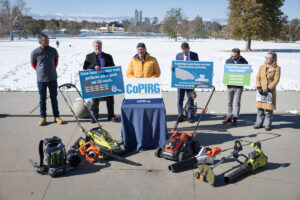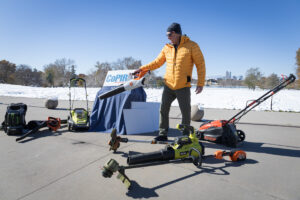National report highlights measurable benefits of electrifying lawn and garden equipment
Updated: November 3, 2023A new report from the CoPIRG Foundation highlights the negative impacts of air pollution produced annually by gas-powered lawn and garden equipment and the measurable benefits of electrifying this equipment across the country. The report is based on 2020 data from the U.S. Environmental Protection Agency’s National Emissions Inventory, with 2020 being the most recent year for which data is available.
Gas-powered lawn and garden equipment—such as lawn mowers, string trimmers, leaf blowers, and chainsaws—are currently the fourth leading contributor to Colorado Front Range emissions, and a major contributor to the formation of harmful ground-level ozone in the region. This equipment also produces a range of harmful emissions that can have significant negative effects on human health, creating both short-term and long-term health risks for individuals exposed to them, as well as negative impacts on plants, ecosystems, and crop yields.
RAQC executive director Mike Silverstein joined CoPIRG at a press event for the report’s release on Monday, Oct. 30, 2023, in support of actions to reduce the use of gas-powered lawn and garden equipment in the Front Range of Colorado, to improve local air quality.
“Electric is our future, in so many ways, over fossil-fuel powered equipment,” said Silverstein.
The numbers add up
The CoPIRG Foundation report includes interactive elements by state and by county across the entire country, detailing data for nitrogen oxides, carbon dioxide, and fine particulates (PM 2.5).
In 2020 alone, the use of gas-powered lawn and garden equipment across the U.S. emitted more than 68,000 tons of nitrogen oxides (NOx) and 350,000 tons of volatile organic compounds (VOCs) into the atmosphere: the two chemical components of ground-level ozone, which triggers asthma attacks and contributes to premature death. This equipment also emitted 30 million tons of carbon dioxide (CO2), the leading cause of global warming, and nearly 22,000 tons of fine particulates (PM2.5): microscopic pollutants smaller than a human hair, like soot, smoke, and dust, that have been linked to respiratory ailments, reproductive and mental health issues, and even premature death.
According to this report, in Colorado, the use of gas-powered lawn and garden equipment emitted almost 2,000 tons of NOx, 775,805 tons of CO2, and 671 tons of fine particulates. The majority of these emissions—almost 80% of each (1,542 tons of NOx, 603,597 tons of CO2, and 531 tons of fine particulates)—were emitted from the 9-county Front Range ozone nonattainment area, where 68% of the state’s population lives (Adams, Arapahoe, Boulder, Broomfield, Denver, Douglas, Jefferson, Larimer, and Weld counties).
While that may not seem like a lot, this is the same amount of NOx emitted over an entire year by more than 880,000 cars. And it would take more than 7 million cars to produce the same number of fine particulates over the course of a year — 4 times the number of cars in Colorado.
In a given year, gas-powered lawn and garden equipment in the 9-county Front Range area emits more volatile organic compounds (VOCs) than all cars on the road in the same region combined. In 2020, gas-powered lawn and garden equipment in Colorado created 9,811 tons of VOCs, 77% of which were emitted in the 9-county Front Range area (7,588 tons). VOCs are a major contributor to the formation of ground-level ozone, and also include benzene, formaldehyde, and 1,3-butadiene, air pollutants linked to increased cancer risk.
Making the transition to electric
No longer limited by cords, electric lawn and garden equipment is cleaner, quieter and, over a lifetime of use, often cheaper than fossil fuel-powered options, as noted in the report. Thanks to recent advances in battery technology, electric equipment is also comparable in quality and performance to gasoline-powered equipment. It’s increasingly easy to find at major hardware stores and suppliers, with dozens of options for electric mowers, trimmers and other types of equipment currently on the market.
Colorado is leading the way in making the transition to electric equipment. A state electrification initiative led by Senator Chris Hanson, who also spoke on Oct. 30 at the report’s release, will enable Colorado residents to receive a 30% “point of sale” instant discount on electric lawn and garden equipment at participating retailers beginning in 2024.
Mow Down Pollution, a RAQC-run program, helps residents, businesses, and local governments transition from dirty, gas-powered equipment to electric alternatives. The RAQC has also submitted a proposal for consideration this December by the Air Quality Control Commission to reduce emissions from lawn and garden equipment in the ozone nonattainment region using grants for government and commercial electrification, discounts on electric equipment, and sales restrictions on gasoline equipment within the nonattainment area.
“Ozone is a significant issue for us,” said Silverstein. “Our proposal would lead to rapid reductions [in air pollution] and fundamental change in our summertime air quality.”



